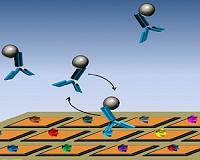 |
Los Angeles CA (SPX) Apr 26, 2011 There's no question, drugs work in treating disease. But can they work better, and safer? In recent years, researchers have grappled with the challenge of administering therapeutics in a way that boosts their effectiveness by targeting specific cells in the body while minimizing their potential damage to healthy tissue. The development of new methods that use engineered nanomaterials to transport drugs and release them directly into cells holds great potential in this area. And while several such drug-delivery systems - including some that use dendrimers, liposomes or polyethylene glycol - have won approval for clinical use, they have been hampered by size limitations and ineffectiveness in accurately targeting tissues. Now, researchers at UCLA have developed a new and potentially far more effective means of targeted drug delivery using nanotechnology. In a study to be published in the May 23 print issue of the journal Small (and currently available online), they demonstrate the ability to package drug-loaded "nanodisks" into vault nanoparticles, naturally occurring nanoscale capsules that have been engineered for therapeutic drug delivery. The study represents the first example of using vaults toward this goal. The UCLA research team was led by Leonard H. Rome and included his colleagues Daniel C. Buehler and Valerie Kickhoefer from the UCLA Department of Biological Chemistry; Daniel B. Toso and Z. Hong Zhou from the UCLA Department of Microbiology, Immunology and Molecular Genetics; and the California NanoSystems Institute (CNSI) at UCLA. Vault nanoparticles are found in the cytoplasm of all mammalian cells and are one of the largest known ribonucleoprotein complexes in the sub-100-nanometer range. A vault is essentially barrel-shaped nanocapsule with a large, hollow interior - properties that make them ripe for engineering into a drug-delivery vehicles. The ability to encapsulate small-molecule therapeutic compounds into vaults is critical to their development for drug delivery. Recombinant vaults are nonimmunogenic and have undergone significant engineering, including cell-surface receptor targeting and the encapsulation of a wide variety of proteins. "A vault is a naturally occurring protein particle and so it causes no harm to the body," said Rome, CNSI associate director and a professor of biological chemistry. "These vaults release therapeutics slowly, like a strainer, through tiny, tiny holes, which provides great flexibility for drug delivery." The internal cavity of the recombinant vault nanoparticle is large enough to hold hundreds of drugs, and because vaults are the size of small microbes, a vault particle containing drugs can easily be taken up into targeted cells. With the goal of creating a vault capable of encapsulating therapeutic compounds for drug delivery, UCLA doctoral student Daniel Buhler designed a strategy to package another nanoparticle, known as a nanodisk (ND), into the vault's inner cavity, or lumen. "By packaging drug-loaded NDs into the vault lumen, the ND and its contents would be shielded from the external medium," Buehler said. "Moreover, given the large vault interior, it is conceivable that multiple NDs could be packaged, which would considerably increase the localized drug concentration." According to researcher Zhou, a professor of microbiology, immunology and molecular genetics and director of the CNSI's Electron Imaging Center for NanoMachines, electron microscopy and X-ray crystallography studies have revealed that both endogenous and recombinant vaults have a thin protein shell enclosing a large internal volume of about 100,000 cubic nanometers, which could potentially hold hundreds to thousands of small-molecular-weight compounds. "These features make recombinant vaults an attractive target for engineering as a platform for drug delivery," Zhou said. "Our study represents the first example of using vaults toward this goal." "Vaults can have a broad nanosystems application as malleable nanocapsules," Rome added. The recombinant vaults are engineered to encapsulate the highly insoluble and toxic hydrophobic compound all-trans retinoic acid (ATRA) using a vault-binding lipoprotein complex that forms a lipid bilayer nanodisk.
Share This Article With Planet Earth
Related Links University of California - Los Angeles Hospital and Medical News at InternDaily.com
 New biosensor microchip could speed up drug development, Stanford researchers say
New biosensor microchip could speed up drug development, Stanford researchers sayStanford CA (SPX) Apr 26, 2011 Stanford researchers have developed a new biosensor microchip that could significantly speed up the process of drug development. The microchips, packed with highly sensitive "nanosensors," analyze how proteins bind to one another, a critical step for evaluating the effectiveness and possible side effects of a potential medication. A single centimeter-sized array of the nanosensors can simu ... read more |
|
| The content herein, unless otherwise known to be public domain, are Copyright 1995-2010 - SpaceDaily. AFP and UPI Wire Stories are copyright Agence France-Presse and United Press International. ESA Portal Reports are copyright European Space Agency. All NASA sourced material is public domain. Additional copyrights may apply in whole or part to other bona fide parties. Advertising does not imply endorsement,agreement or approval of any opinions, statements or information provided by SpaceDaily on any Web page published or hosted by SpaceDaily. Privacy Statement |